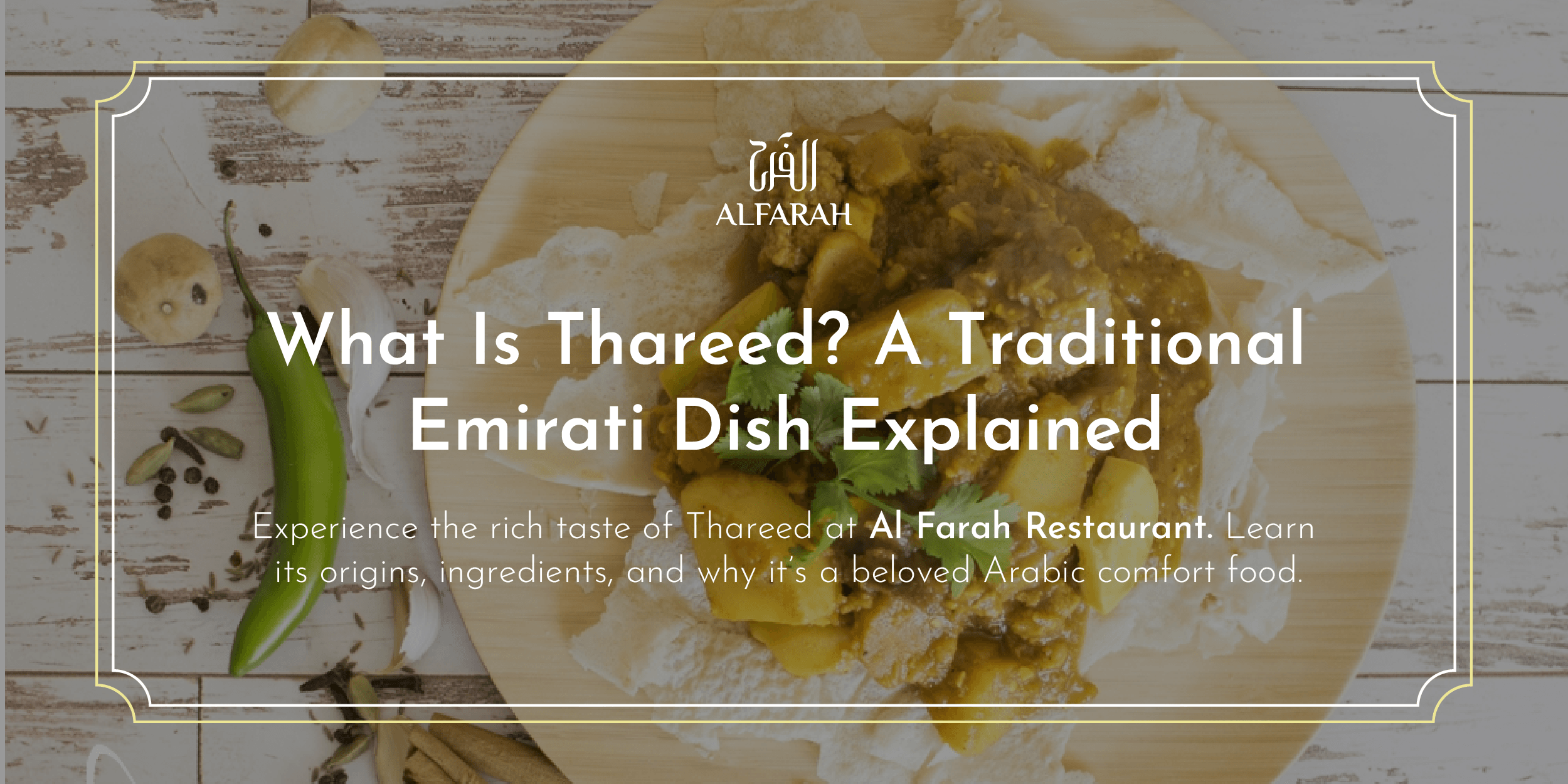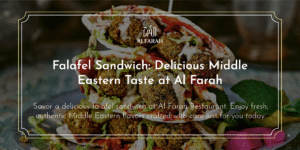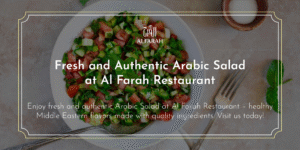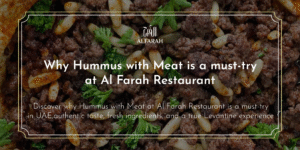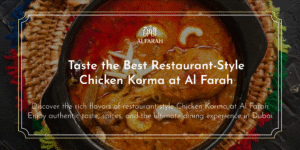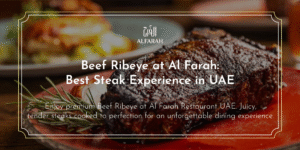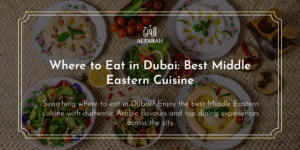Thareed is a beloved traditional Emirati dish that has been passed down through generations. Known for its warm, comforting essence, this dish is made by combining slow-cooked meat or vegetables with spiced broth and layering it over thin Emirati bread. Commonly referred to as the Arabian stew, Is not just food—it’s a cultural experience.
It holds particular significance during Ramadan, as it’s a staple at iftar tables across the UAE and the wider Gulf region. But beyond its religious ties, Thareed reflects the resourcefulness and flavor-rich history of Emirati cuisine.
The Origin and Cultural Significance of Thareed
Thareed dates back to the time of the Prophet Muhammad (PBUH), who reportedly loved this dish. It’s often described as a Sunnah food and holds a deep religious and spiritual value for many Muslims. It was traditionally prepared using simple ingredients available in the desert: dried bread, water, meat, and local spices.
In Bedouin times, Thareed represented sustainability, nourishment, and community sharing. Today, it still evokes the same values but with enhanced flavor profiles thanks to modern cooking methods and ingredients.
What Makes Thareed Unique?
Thareed is often compared to dishes like stew or soup, but it’s much more than that. What sets it apart is:
- Emirati Raqaq Bread (traditional thin flatbread)
- Slow-cooked lamb, chicken, or vegetables
- Rich broth infused with Emirati spices
- Layering technique where the bread absorbs the flavors
This layering technique ensures the bread softens and soaks in the spices and juices, making each bite flavorful and hearty.
Ingredients in Traditional Emirati Thareed
Here’s a breakdown of the common ingredients used in a typical Emirati :
- Raqaq bread or thin khubz
- Lamb meat (or chicken)
- Tomatoes
- Potatoes
- Carrots
- Zucchini
- Onion and garlic
- Tomato paste
- Baharat (Emirati mixed spices)
- Turmeric, cumin, cinnamon, black pepper
- Fresh coriander and parsley
- Water or meat broth
For a vegetarian thared, meat can be replaced with more vegetables like eggplant, pumpkin, and beans.
Types of Thareed Dishes in the UAE
To cater to all dietary preferences, Thareed has evolved into different variations:
1. Lamb Thareed
Lamb Thareed is considered the most traditional and authentic form of the dish in Emirati cuisine. Made using bone-in lamb pieces, the meat is slow-cooked to develop a deep, rich flavor that seeps into the broth. The bones add a natural depth and fattiness that elevate the overall taste.
The spices used typically include Emirati baharat, turmeric, black lime (loomi), cumin, and cinnamon, creating a warm and aromatic profile. Carrots, potatoes, zucchini, and tomatoes are common vegetables used in this version, cooked until soft. Once ready, the hot stew is poured over thin layers of raqaq bread, allowing the bread to soak up the flavorful juices.
2. Chicken Thareed (Thareed Dajaj)
Chicken Thareed is a lighter variation of the classic lamb recipe and is often preferred by those looking for a less fatty or more easily digestible meal. It uses skinless chicken pieces, often with bones for added flavor.
The broth in mildly spiced, often featuring cardamom, cinnamon, black pepper, and turmeric. The vegetables used remain mostly the same, but some recipes also add green beans or okra for variation.
Due to its lighter composition, Chicken Thareed is a common weekday meal in Emirati households. It’s also served in restaurants catering to those who want a traditional dish without the heaviness of red meat. It’s equally nutritious, delicious, and perfect for families with children or the elderly.
3. Vegetarian Thareed (Thareed Nabati)
Vegetarian is an inclusive and health-conscious version of the dish, perfect for those following a plant-based diet or fasting from meat. Instead of lamb or chicken, it relies on a rich blend of root vegetables and legumes like:
- Pumpkin
- Sweet potato
- Eggplant
- Lentils or chickpeas
- Tomatoes and zucchini
The stew is seasoned with traditional spices and herbs, making it just as flavorful as its meat-based counterparts. Some modern recipes may use vegetable broth to enhance the umami flavor.
Vegetarian is a popular choice during religious fasts or among visitors who prefer meat-free options. It still offers a satisfying experience thanks to the thick broth and the iconic bread layering method.
4. Seafood Thareed
Seafood Thareed is a contemporary twist on the traditional recipe and is inspired by the coastal heritage of the UAE, particularly in areas like Dubai, Abu Dhabi, and Ras Al Khaimah. This version features fresh fish fillets (like hammour or kingfish) or shrimp, gently cooked in a tomato-based broth.
The flavors lean toward a zesty, aromatic profile, often with the addition of saffron, dried lemon, and coriander. The seafood is cooked just until tender to maintain its delicate texture. The broth is then poured over the raqaq bread, which soaks up the oceanic flavors beautifully.
Seafood is often featured in fusion Emirati restaurants and appeals to both locals and tourists looking to try something new while staying rooted in cultural cuisine.
How Is Thareed Prepared? (Cooking Method)
Here’s how is usually prepared in Emirati homes and restaurants:
- Sauté aromatics like onion, garlic, and spices in oil or ghee.
- Add the meat and brown it gently to seal in the flavor.
- Add vegetables (carrots, potatoes, zucchini) and stir.
- Pour in broth and tomato paste; simmer until meat is tender.
- Layer raqaq bread in a serving dish and pour the stew on top.
- Garnish with herbs and serve hot.
Thareed is often served with dates, laban (buttermilk), or pickles.
Nutritional Value of Thareed
Thareed is both wholesome and satisfying:
- Protein-rich when made with lamb or chicken
- High in fiber and vitamins from the vegetables
- Moderate in carbs from the bread
- Hydrating and replenishing—making it perfect for Ramadan
When cooked with minimal oil and lean meat, it’s also a healthy meal option.
Thareed in Ramadan: A Spiritual Connection
During Ramadan, \Is a spiritual and physical comfort. It is:
- A Sunnah dish (the Prophet Muhammad PBUH enjoyed it)
- Easy to digest after long fasting hours
- Shared among families as a symbol of unity and tradition
In many UAE households, no iftar table is complete without Thareed. Restaurants like Al Farah proudly serve authentic during Ramadan specials.
Where Can You Try Traditional Thareed in the UAE?
If you’re craving a taste of real Emirati Thareed, head to a local restaurant that specializes in traditional Gulf cuisine.
At Al Farah Restaurant, we serve slow-cooked, richly spiced Lamb and Chicken Thareed, prepared using traditional Emirati methods. Whether you’re a local or tourist, our chefs ensure an authentic experience that honors the roots of this dish.
Book Now at alfarahrestaurant.com and enjoy Thareed like never before.
conclusion
Thareed is not just a dish—it’s a story. A story of heritage, humility, and hospitality. Whether served in a traditional Emirati home or a high-end restaurant, continues to connect hearts and generations.
So next time you wonder, think beyond ingredients—think culture, comfort, and community.
FAQ
Thareed is made using slow-cooked lamb or chicken, vegetables like carrots and potatoes, Emirati spices, and traditional raqaq bread. The bread is layered underneath the stew to absorb its rich flavors.
While is especially popular during Ramadan, it is enjoyed year-round in the UAE and other Gulf countries. It’s considered a comfort food and a cultural staple in many households.
Thareed has a rich, hearty flavor with warm spices, tender meat, and soft bread that absorbs the broth. It’s savory, mildly spicy, and deeply satisfying—perfect for family meals.
Yes, Is a nutritious dish when made with lean meat and fresh vegetables. It provides protein, fiber, and essential vitamins, making it a balanced option for any meal.


